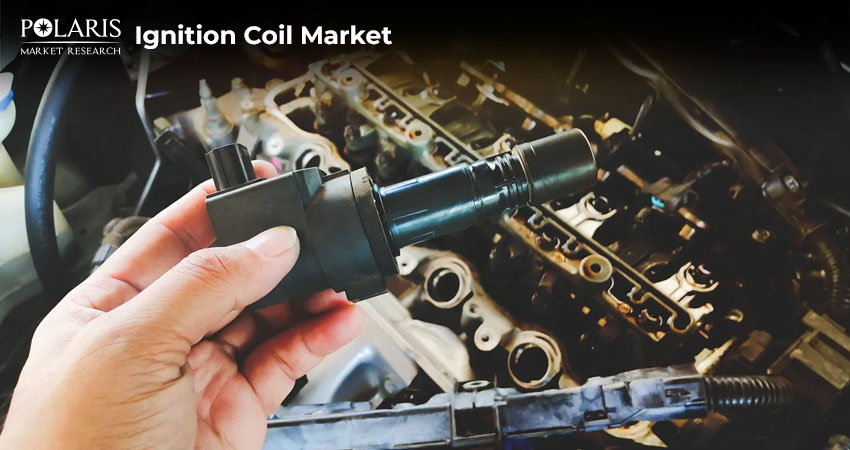Understanding the Role of Ignition Coils in Modern Automotive Combustion

The ignition coil is a vital component in the intricate system of modern automobiles. Tucked within the engine bay, this component is responsible for initiating the combustion process that powers internal combustion engines. While spark plugs often get the spotlight, it’s the ignition coil that provides the high voltage necessary to generate the spark.
With automotive technology evolving, the role and design of ignition coils are also advancing. This blog post details the fundamentals of ignition coils, explaining to you their history and how they work. Also, it covers the current state of the ignition coil market and the key factors that are propelling it forward. Continue reading!
Ignition Coils: Introduction
An ignition coil is an essential component of a car’s ignition system. It takes the low-tension current (12-volt output) from the battery and transforms it to high-tension current (as much as 45,000 volts). The high-tension current is then supplied to the spark plugs of the engine. In essence, an ignition coil is a wire-wound transformer filled with an insulator.
Ignition systems have undergone significant evolution over time. Today, these systems incorporate several electronic components. However, they still carry the features of the first ignition systems that first appeared over a century ago.
History of Ignition Coils
The development of the first coil-based ignition system is attributed to Charles Kettering. He introduced coil ignition for a leading automobile manufacturer during the early 1910s. The system was significant as it was the first to combine the ignition system and the starter motor into a single electrical system.
The Kettering ignition system included a battery, an ignition coil, breaker points, a capacitor, and a distributor. When the ignition switch was closed and the engine was cranked, the battery provided current to the primary winding of the ignition coil. This current flow created a magnetic field. The magnetic field collapsed when the breaker points were opened, inducing a high voltage in the secondary winding of the coil. The high voltage was then directed to the distributor, which directed it to the appropriate spark plug to ignite the fuel-air mixture.
The Kettering ignition system continued to be the virtually only ignition system type for mass-produced petrol vehicles for several decades. They were eventually replaced by electronically switched and controlled ignition systems during the later part of the 20th century.
Key Market Stats
The rising preference for personal vehicles over public transportation in many emerging economies, such as India and China, is fueling the sale of vehicles. The increased car sales have led to increased demand for essential components like ignition systems. The growing adoption of hybrid vehicles, which need advanced ignition systems that can work with their complex engines, is further fueling market demand.
Our latest market analysis reveals the ignition coil market to register a CAGR of 4.3% during the forecast period, 2025 to 2034. The market was valued at USD 15.54 billion in 2024. It is projected to grow to USD 23.72 billion by 2034.
Working of Ignition Coils
Ignition coils act as step-up transformers. They convert the low-voltage battery power into high-voltage electricity needed to create a spark in the engine's combustion chamber. Here’s a more detailed breakdown:
Primary Coil: The primary coil is the low-voltage winding within the ignition coil. It draws a low-voltage current from the battery, typically 12 volts. The passage of the current through the primary coil results in the creation of a magnetic field.
Secondary Coil: The secondary coil is a high-voltage winding housed within the ignition coil. It often has many turns compared to the primary coil. The magnetic field from the primary coil induces a current in the secondary coil through mutual induction. This induced voltage in the secondary coil is significantly higher than that of the primary coil.
Magnetic Field Collapse: The magnetic field collapses rapidly when the circuit to the primary coil is interrupted. This rapid collapse induces a high-voltage surge in the secondary coil.
Spark Plug Activation: The high-voltage electricity from the secondary coil travels to the spark plug. The high voltage overcomes the air gap in the spark plug, resulting in the creation of a spark. This spark ignites the air-fuel mixture in the combustion chamber of the gas engine and initiates the combustion process.
Types of Ignition Coils
Below is an explanation of the various ignition coil types:
Conventional Ignition Coils: Conventional ignition coils can be widely found in older automobiles. These coils are usually placed on the outer portion of the engine. They include a metal canister that houses the secondary and primary windings. These coils are linked to the distributor. The distributor is responsible for distributing the high voltage to the spark plugs. They are characterized by their relatively simple design and are renowned for their reliability.
Distributorless Ignition System (DIS) Coils: Advancements in ignition technology have led to the development of DIS coils. These coils are usually placed directly on the spark plugs. In some systems, they may be placed close to the spark plugs. As such, a distributor is not needed with these coils. Each of the DIS coils supplies high voltage to a specific park plug. The DIS system makes use of automotive sensors to determine the specific time of spark generation for every cylinder.
Coil-on-Plug (COP) Ignition Coils: These ignition systems have their own ignition coil for each cylinder. The coil is mounted directly on the spark plug. This configuration takes away the requirement for spark plug wires, providing highly efficient ignition. These ignition coils are known for their improved spark energy and enhanced combustion control.
To Sum It Up
Ignition coils stay hidden beneath the cover of the engine. But they play a central role in every combustion cycle. From starting the car to maintaining engine smoothness on the highway, ignition coils are vital for ensuring reliability, performance, and efficiency. As technology continues to advance, the ignition coil market is expected to witness rapid transformation in the coming years.

